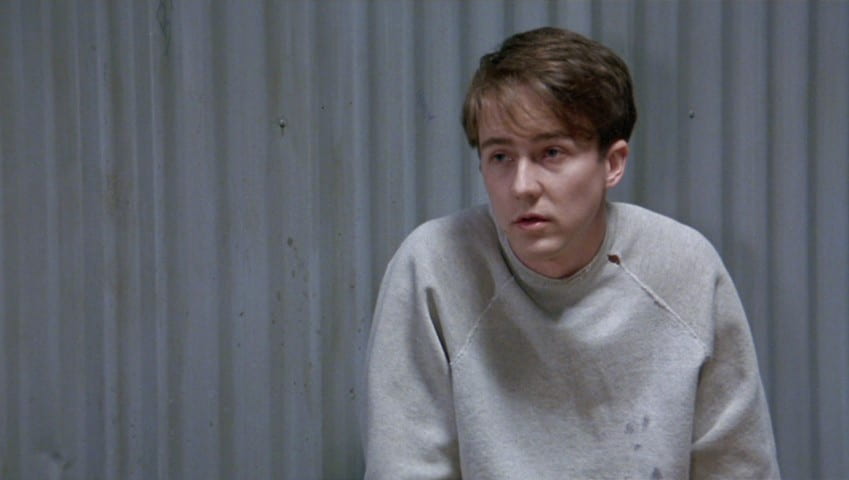The Psychology of Aaron/Roy in Primal Fear (1996) By MG.
Primal Fear – directed by Gregory Hoblit
The 1996 film “Primal Fear” starring Edward Norton and Richard Gere is a film that I find particularly interesting to discuss. Rather than looking at philosophy in this blog, I will be focusing on the psychology of the main character Aaron/Roy and some of my critiques towards portrayal of mental illness and films.
Here are the main plot points, although I would suggest watching the film first as I will spoil it in its entirety:
- Martin “Marty” Vail is an extremely prominent and narcissistic defence attorney in Chicago, spending his career getting high-payed clients off crimes they have committed.
- A murder has been committed, the respected Archbishop Rushman has been murdered and mutilated in his apartment and Vail sees the news report about an arrest.
- The person who has been arrested is Aaron Stamper, a stuttering 19-year-old altar boy who experiences “black-outs,” who was caught running away from the scene of the crime, covered in blood.
- Vail decides to represent Aaron pro-bono in order to gain more publicity from the trail.
- The trial commences and Aaron pleads not guilty, Vail’s former girlfriend is the prosecutor and it is discovered that the Archbishop is not all as he seemed. He, in fact, has connections with civic leaders and corrupt politicians/attorneys.
- Not only this, Vail finds a tape recording that proves the Archbishop has been sexually assaulting altar boys, in particular Aaron and his girlfriend, Linda Forbes.
- This dilemma sets in motion the rest of the film as Vail confronts Aaron about why he lied to him.
- Aaron breaks down and here we see a shift in persona, he becomes a violent sociopath who names himself, “Roy.” Roy confesses to the crime.
- When the incident is over, Aaron cannot remember what happened – it appears he has blacked out again.
- The psychiatrist examining Aaron states that he likely has dissociative identity disorder, which was likely caused by the years of abuse from his father and the Archbishop.
- However, this creates conflict as they cannot enter an insanity plea during an ongoing trial.
- As a result, Vail ends up putting Aaron on the witness stand where he probes him for information and brings up his abusive childhood and the Archbishop, with new information coming to light that the Archbishop molested countless other young men. The prosecutor, Vail’s former girlfriend (Janet Venable), questions Aaron harshly.
- During this time, Aaron “turns” into Roy and threatens to snap the prosecutor’s neck if anyone comes close.
- He is subdued and the judge, having witnessed Aaron’s apparent insanity, dismisses the jury, and finds Aaron not guilty by reasons of insanity and it sentenced to a mental institution.
- Janet, unfortunately, is fired for allowing the dealings of the Archbishop and the corrupt attorneys to come to light.
- In the final moments of the film, Vail visits Aaron in his cell to tell him what has happened, Aaron states that he recalls nothing of what just happened.
- Despite this, just as Vail is about to leave, Aaron says, “tell Miss Venable I hope her neck is okay,” which Vail, as he is walking away, points out that is something he could not have known as he has “lost time.”
- Aaron reveals that he was lying and pretending the whole time, he no longer stutters and reveals that he did not make up the identity of Roy, he made up the identity of Aaron.
- He reveals that he did not only kill the Archbishop but his former girlfriend, Linda.
- Vail is shocked at how easily manipulated he was by his own client. He has won the case, but he is completely ashamed as he actually began to care for “Aaron”. He walks away, Aaron/Roy calling after him, taking the back door away from the public eye and takes a taxi away from the courthouse.
The psychology of Aaron/Roy:
“No man, for any considerable period, can wear one face to himself and another to the multitude.” —The Scarlett Letter, Nathaniel Hawthorne
If we analyse Aaron’s behaviour over the course of the film, we can see that he does, indeed, meet many of the criteria for dissociative identity disorder. Dissociative identity disorder is caused by “overwhelming experiences, traumatic abuse occurring in childhood,” the disturbed attachment between child and guardian, such as neglect, or abuse can stop a child from developing a “unified sense of self,” or a main personality and, therefore, the trauma in the individuals, over time, leads to the development of alternate identities. These alternate personalities can be a different age, gender, race, sexuality or not even human at all and, during childhood, serve as a protector by keeping traumatic memories within a specific alter. This is shown directly with Aaron, as his mother is described to have died and his father was not a “nice man,” further exemplified by his abuse at the hands of Archbishop Rushman.
If we look into the DSM criteria for dissociative identity disorder, we can further see how Aaron seems to be a clear case of it:
- Distinct Personality States refers to the separate identities that appear to be different people, they are often referred to as “alters.” This can be shown by two or more distinct personalities manifesting themselves. The psychiatrist sees one host personality (Aaron) and the alter (Roy).
- Sense of self and Agency which describes the distinctiveness of the personalities, such as their outlook, attitudes, and preferences. When we first meet Aaron, he is shown to be a shy, stuttering boy who seems to be able to do no harm. However, Roy is more outspoken, more aggressive and seems to have sociopathic traits; the way they speak and behave is completely different leading the psychiatrist to further suspect DID.
- The switching of personalities is caused by anxiety and stressful events. When the psychiatrist mentions Linda a switch occurs, in the trial when he is being antagonised – a switch occurs which points to it being a clear psychological defence mechanism.
- Recurrent Amnesia can occur when an individual has “lapses in memory,” and “gaps in past memory and personal life.” This is evident within Aaron, as he describes to the psychiatrist that he “loses time,” and cannot recall ever being at the scene of the murder, this type of amnesia cannot be explained by just forgetfulness. This is further shown the varying degree of amnesia between Roy and Aaron, Aaron cannot remember anything Roy has done – whereas Roy has more agency.
Treatment for Dissociative Identity Disorder
The primary treatment that would be received for an individual with dissociative identity disorder would be psychotherapy which is often regarded as ‘talk therapy,’ this type of therapy allows for a professional to better understand what a particular individual may be going through in regards to their mental health. In regard to the context of the film, Aaron would most likely receive desensitised therapy in which the aim is to remove a negative response towards phobias/anxiety and other fears. In Aaron’s case, this would be to try and remove negative thoughts and feelings towards information relating to the murder, Linda, or his past. Medication may also be prescribed, however, there is not a main set of medications specifically for dissociative identity disorder. Some of the drugs that Aaron could be prescribed with are: anti-anxiety medications, antidepressants, or antipsychotic drugs.
I think the portrayal of Aaron with dissociative identity disorder was compelling, at the beginning of the film you are hooked into who this character is and whether he actually committed the murder. However, there are some critiques that I have for the portrayal of mental health especially the malingering presented at the end of the film.
Malingering and Misdiagnoses
In the end, when it revealed that there never was an “Aaron” personality only a “Roy,” initially was a shock twist and not expected as Aaron/Roy’s story was so convincing. It turns out that Aaron/Roy was simply playing a role and faking his DID. Malingering is the production of false or exaggerated physical or psychological symptoms with the end goal of receiving some kind of reward. In the context of the film, Aaron/Roy fakes dissociative identity disorder in order to avoid legal punishment, likely the death penalty which was pushed by the prosecutor. Since Aaron/Roy’s true diagnoses are not fully explained in the film, all we can do is speculate. However, I think he most likely has a form of antisocial personality disorder and is on the sociopathic spectrum as he fits the main diagnostic criteria, such as:
- Hostile, disrespectful behaviour towards others.
- Persistent lying and deceit to exploit others, in particular manipulating others for personal gain – “There never was an Aaron, Counsellor.” – Aaron/Roy to Marty.
- Impulsiveness and failing to plan ahead: a trait of people with sociopathic tendencies compared to psychopathic tendencies is that crimes committed by sociopaths are impulsive and, therefore, they tend to leave evidence – “Yeah, I did get caught though, didn’t I?”
- Lack of remorse and empathy for what they have done. He killed his girlfriend because he thought “she deserved it” and that killing Archbishop Rushman was a “work of art.”
So, this leads to the question – why was Aaron/Roy misdiagnosed?
To speculate, Aaron may have been misdiagnosed due to the lack of objectivity from the psychiatrist that diagnosed him. Upon meeting Aaron, she states that amnesia could be a sign of malingering but never comes to that conclusion with Aaron. One reason for this could be the fact that she clearly was eager to study an individual with dissociative identity disorder, in the film it’s clear that she looked more for evidence that supported the diagnoses rather than looking, comprehensively, at all the evidence. It is evident that dissociative identity disorder is extremely difficult to diagnose, with no specific test allowing for a diagnosis. As such, those with dissociative symptoms are estimated to spend around seven years before being properly diagnosed, contrasted with the 60 hours that the psychiatrist spent with Aaron/Roy.
Issues with films and portrayals of mental illnesses
Films tend to sensationalise mental illness to such an extent some people believe that an individual has “control” over their mental problems. Another film that portrays DID, “Split,” is guilty of this sensationalism and stigmatisation around mental disorders. In comparison to Split, I think the film Primal Fear, if we disregard the malingering, gives a better portrayal of dissociative identity disorder. However, the film is still a “psychological thriller,” and, therefore, the twist at the end, although not expected by many, is a common trend within movies.
Considering the actual ending of the film, I think it is captivating to analyse further. Since the film focuses more on shock value at the end it does not explore the real character of Aaron/Roy, rather that he is simply an antagonistic sociopath.
References
Grohol, J. M., 2020. Antisocial Personality Disorder Symptoms. [Online]
Available at: https://psychcentral.com/disorders/antisocial-personality-disorder/symptoms/
MD, H. W. L., 2007. Malingering: Key Points in Assessment. [Online]
Available at: https://www.psychiatrictimes.com/view/malingering-key-points-assessment
Traumadissociation, n.d. Dissociative Identity Disorder. [Online]
Available at: http://traumadissociation.com/dissociativeidentitydisorder.html
Webermann, A. R. & Brand, B. L., 2017. Mental illness and violent behavior: the role of dissociation. [Online]
Available at: https://bpded.biomedcentral.com/articles/10.1186/s40479-017-0053-9


